TITLE
Illuminating the Silence: Body as Symphony
CONCEPT
The body has been long seen as a void and a passive medium on which cultures are implanted. In both Sartre’s and Beauvoir’s work, “the body” is figured as a mute facticity, anticipating some meaning that can be attributed only by a transcendent consciousness. In other words, the body itself signifies nothing. What if the body is never prior to significance? It is constantly responding to the outside world, and interacting with it, too. It expresses feelings actively in a way that is neither visible nor hearable, and thus it is oftentimes neglected as if it has always been a white canvas on which things happen. The piece hopes to convey the idea that the body is never a void, but rather an active subject. By using hands to the body, it is lit up and sings based on the position of the hands.
RESEARCH & DEVELOPMENT
Main Idea:
The body is actively responding to the environment but it doesn’t speak for itself. The project helps the body to show colors and sing out its feelings.
Inspirations:
Plant Communication:One of the inspirations for our work comes from watching the Plant Talk video in our Week 3 Assignment. Plants emit sounds when they lack water, albeit very faint, requiring special equipment to be heard. Similarly, the human body constantly interacts with the external environment, responding to stimuli, although it doesn’t speak for itself. Therefore, one of our inspirations is to create clothing that allows our bodies to be heard.
We want to make the body audible and interactive: Both of us are very fond of things that can make sounds, and we want people with this new body to be able to play with their bodies as an instrument. We hope that sound can be produced from multiple parts of the body, with each part generating different interactions and thus different sounds through different movements. To highlight different parts, we feel the need to incorporate neopixels into our design. When sound is produced, the neopixels of that particular area will light up to signify which part has produced the sound.
Materials: Fish Bone, Various White Clothes
Equipment: Arduino, Processing, Lilypad, Velostat, XBee
Methodology & Sketch: (textile//circuit+coding)
With our inspiration and the knowledge we have gained, we have embarked on the plan to construct the new body.
In terms of coding and circuitry, our main principle follows Arduino sensing the values of velostat, transmitting them to neopixels within Arduino, while also sending them to processing to generate different sounds. We also utilized Xbee to make our device capable of wireless functionality.
For the outfit design, we have chosen to use fishbones as a framework to build our entire body, dividing it into many sections. We intend to use different white textiles as the fabric for each section. We have three velostats planned to be placed respectively on our clavicle (neck), abdomen, and the upper side of the thighs, with their corresponding neopixels fixed onto the framework surrounding the body constructed by fishbones.
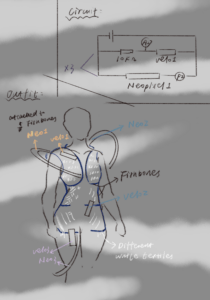
Experiment 1 (Build Fishbones)
Chanel and Luna are both novices in making clothes. We bought fishbones, but we were worried that we wouldn’t know how to assemble them. Most tutorials online teach how to sew fishbones together using a sewing machine, but neither of us knows how to use one. So Luna searched for “how to make a suit” and came across the following image, realizing that we could use the lines on it to structure the fishbones.
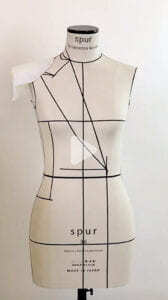
Chanel suggested using hot glue to stick multiple fishbones together at the joints. So we brought in a human-shaped mannequin, figured out where to build the fishbones (as shown in the figure below ), and began constructing them on it. (Haha! We realized we didn’t even take a picture of us building the fishbones because we were so busy and forgot…)
By now, we had turned it into a garment that could be worn on a person by using fishbones. Later, when fixing the neopixels to the clothing, we still used three fishbones to respectively secure them at several nodes where the fishbones connect, creating a 3D wrap-around effect.
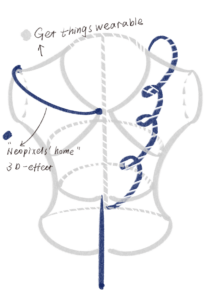
Experiment 2 (Making Different white textiles)
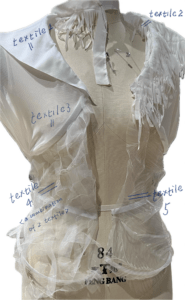
The overarching design concept behind our use of white fabrics is to convey a sense of being easily overlooked, lightweight, and responsive to the external environment, much like a blank sheet of paper. By employing various white materials, we aim to highlight the complexity of our body as well.
-Textile 1: Solid White fabric
As for one side of the collar, there’s nothing particularly special about it, making it easy to overlook. However, below, from our collarbone to the shoulder, lies a position that people unconsciously touch in their daily lives. Here, we’ll place a velostat.
-Textile 2: White fabric with long “fur”
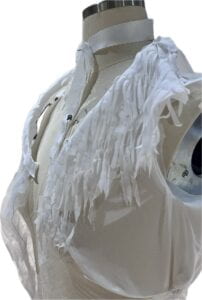
On the other side of the collar, there are numerous long strips of fur. When the wearer moves, these fur pieces sway, visualizing our body’s response to the external environment. Additionally, this textile was later also used as a decoration covering another velostat, which should have been placed on the upper side of the thighs.
-Textile 3: Semi-transparent frosted white fabric
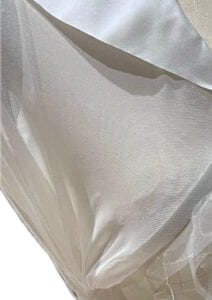
We have used this type of textile on both the chest and upper back. It is semi-transparent (but not as transparent as other materials), giving a soft and delicate feel, so we decided to use this material on the chest. Additionally, this textile was later also used as a decoration covering another velostat, which should have been placed on the abdomen.
-Textile 4: White fabric with sparkles and silk-like translucent white fabric
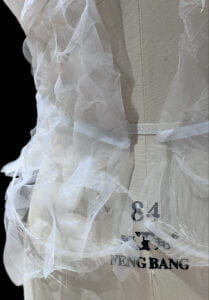
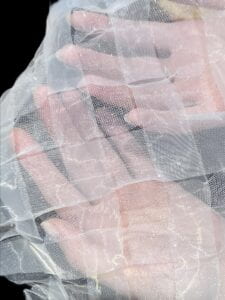
This piece of fabric took us the longest time because we first needed to cut two different materials into long strips and then weave them together following the method we used to weave apple and banana peels in our Week 5 assignment. However, these two types of fabric were prone to sticking to other fabrics—one was slippery, and the other was more furry—so both cutting and weaving took us some time. After weaving, we sewed threads along the edges to secure this piece of fabric and then attached it to the fishbones.
-Textile 5: Translucent rippled silk-like white fabric
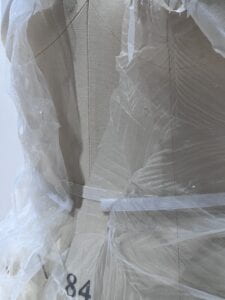
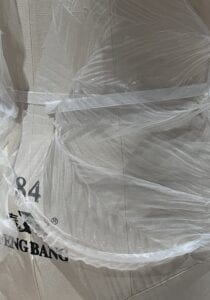 This piece of fabric was attached to the other side of the front of the body as well as the lower back. One reason is that we were too lazy to make a second piece of fabric similar to textile 4. The second reason is that we really liked the texture of its lines, which resembled various textures and nerves within the human body. (The second reason seems like an excuse for the first one, haha!)
This piece of fabric was attached to the other side of the front of the body as well as the lower back. One reason is that we were too lazy to make a second piece of fabric similar to textile 4. The second reason is that we really liked the texture of its lines, which resembled various textures and nerves within the human body. (The second reason seems like an excuse for the first one, haha!)
Experiment 3: Coding
-Arduino
We used the code from Week 3 Exercise 1: Lilypad regarding neopixels and modified it because we used three neopixels and needed to send values from three velostats to processing.
Arduino Code:
https://docs.google.com/document/d/1BvsPCKTbo33anqJgIbKLHdOq0qn52-X7fYm0E52OLcc/edit
-Processing
Under the introduction of our friend Freddie, we utilized the sine wave from the Processing library as a foundation for modification. Additionally, we referred to the code from Interlab, which facilitates the transmission of data from Arduino to Processing, enabling the values from our velostats to be transmitted to Processing. We mapped these three values as variables to be associated with the frequency and amplitude of the sound. Professor Gohi also helped us with the port problem. (By now our coding can run and utilize the sound and neopixels!) We were very excited when we achieved this at Monday’s midnight! Yet, everything changed when we met Xbee the next day😇😇
ProcessingCode:
https://docs.google.com/document/d/1BvsPCKTbo33anqJgIbKLHdOq0qn52-X7fYm0E52OLcc/edit
-Xbee
We needed Xbee to make our work wireless (without having to be constantly connected to the computer to receive the values from Processing). Chanel and Luna looked at the Xbee instructions in the IMA studio at 2 a.m. on Monday but still didn’t know what to do, so we decided to seek advice from Professor Marcela on Tuesday. She helped us utilize the Xbee software and did some coding. However, after installing Xbee, Processing was unable to receive values, and the port kept showing as busy or unavailable. Later, Professor Marcela helped us add a few lines of code to Arduino and reorganize the code in Processing. Finally, our code started running with Xbee. (Thank you, Marcela!)
Experiment4 (Alligator Clips)
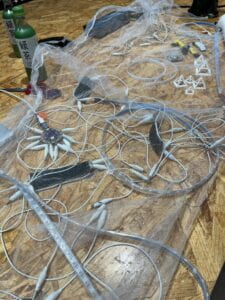
We used alligator clips to connect the circuits at first so that it was easy to test where went wrong. Since we wanted the LED lights and the sound to be varied, we decided to use velostats to control the electric current and sewed three of them over the weekend.
Experiment5 (Soldering Wires)
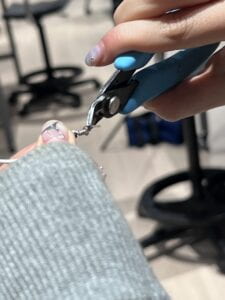
After succeeding in making things work using the alligator clips, we switched to soldering wires, which can be cut into different lengths and have a better bendability, thus better for wearables. We replaced all the alligators clips with the wires and cut the length of some parts that did not need to be long (e.g., the wires between the resistors), and we measured the length from the lilypad to the three velostats that were supposed to be attached to certain parts of the body, like the collarbone and waist. With everything done, we connected one of the XBees with the Lilypad so that the whole piece can work without connecting to the laptop (using the XBee code mentioned above, with another XBee connected to the laptop to send signals). Finally, we connected a powerbank to the Lilypad to power it up and it could work wirelessly (though it was still with a lot of soldering wires, but it did not need to be connected to the laptop to receive the code nor gain power).
Each Team Memeber’s contribution
We did most of the parts together. From generating ideas to making clothes, from coding to building the circuit. From delight to despair and from despair to delight (not so much delight😬)! Chanel sewed the three velostats herself at the weekend to save Luna’s life (since Luna was busy with other midterms by then. XOXO from Luna <3333) And of course, great thanks to our professor Marcela for helping us with Xbees and pointing out right direction for us!😚And thanks Gohai! Andy and Freddie for helping us with the code🪄!
Finished Work:
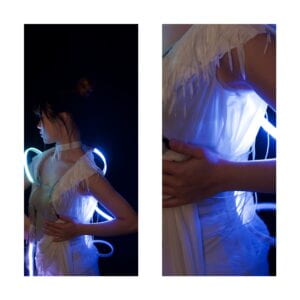
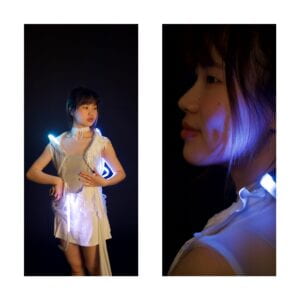
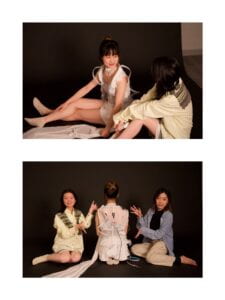
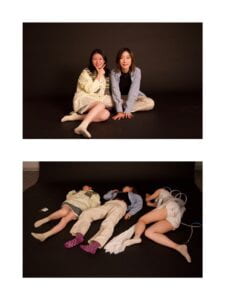
Chanel’s Conclusion:
Our project helps the body to be seen and heard augmented by sensors so that it can speak for itself. I feel glad that we had the opportunity to explore different materials and techniques. For instance, the clothes was made using different fabrics, including solid white, half-transparent, and transparent materials, and we also cut and wove some of them into patterns. It took hours to build the holder using fish bond and compose different materials into one piece but the outcome was worthwhile. In addition, the project gave me the confidence that I have a good command of connecting soft circuits and sensors, while there is still a lot to learn in Arduino and Processing.
The project, overall, I believe is a good response to the prompt. Since the body in a conventional sense is perceiving the world silently, we distorted the nature of it and helped it to speak up using lights and sounds. One great suggestion from the presentation day is that the positions of our three velostats should have been in places where there is a meaning. For instance, when the two arms are hugging the body, it sings, and that requires the velostats to be around the waist. In a way, it can be more visually performative. We do have two velostats somewhere there, but we didn’t pay too much attention to the model’s gestures when interacting with it.
We had a hard and long time designing the clothes, but Luna has been a perfect teammate who was always there to work and support even with a heavy workload from other classes. She provided a few excellent ideas about the usage of materials and how to position the NeoPixels, and she has a clear mind to organize the progress and document. During the presentation, I was very astonished by the simple yet smart designs by our classmates, and Luna and I believed that instead of devoting much time to designing a beautiful, traditional dress, we should have focused more on its functionality and the idea it conveys (though we had a long time doing that as well, I think we should have cut some time of making the clothes).

great work Chanel!
I think you should continue with this idea and develop more the wearable design and the kinetic part, but the sound it’s really nice and original in your project.